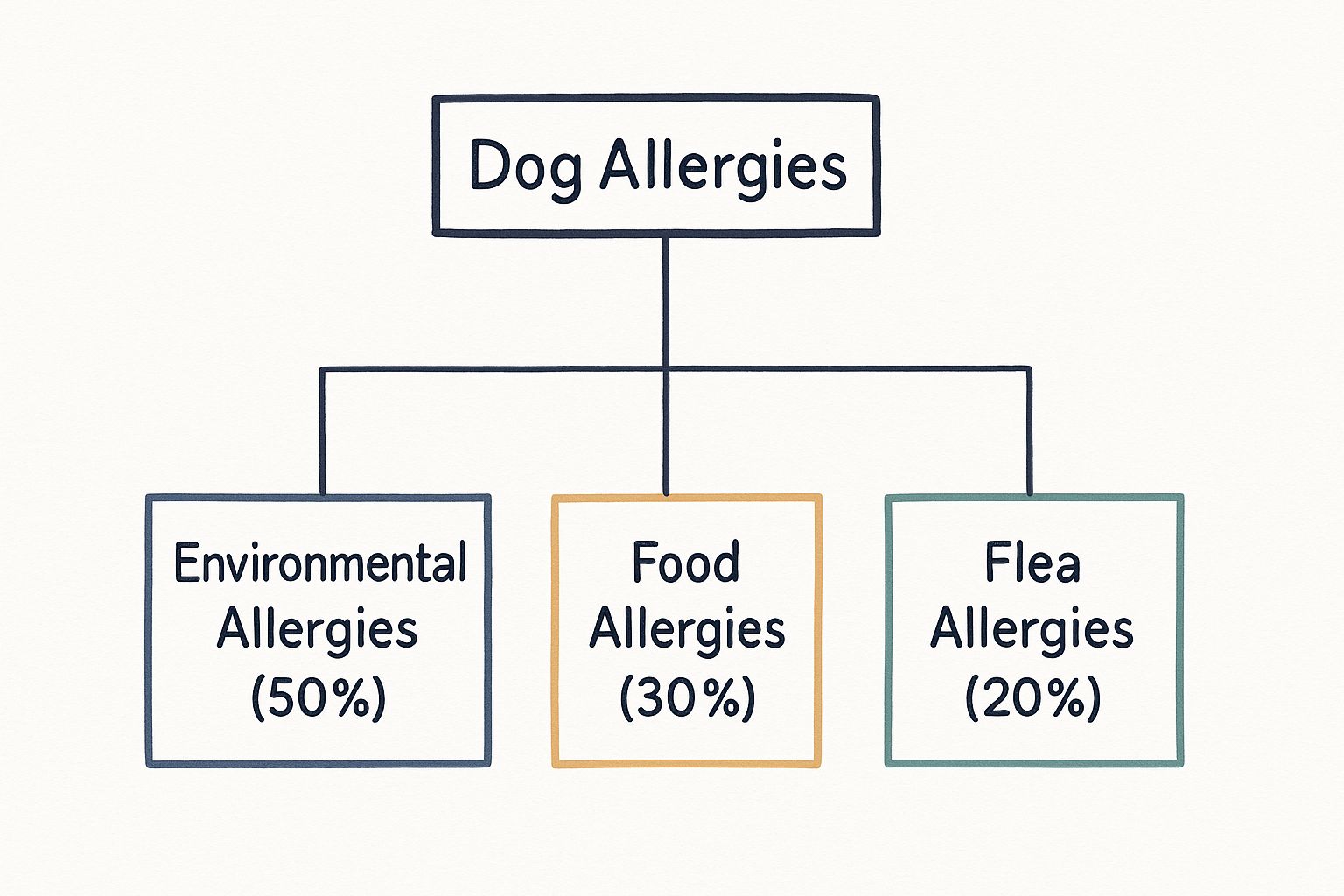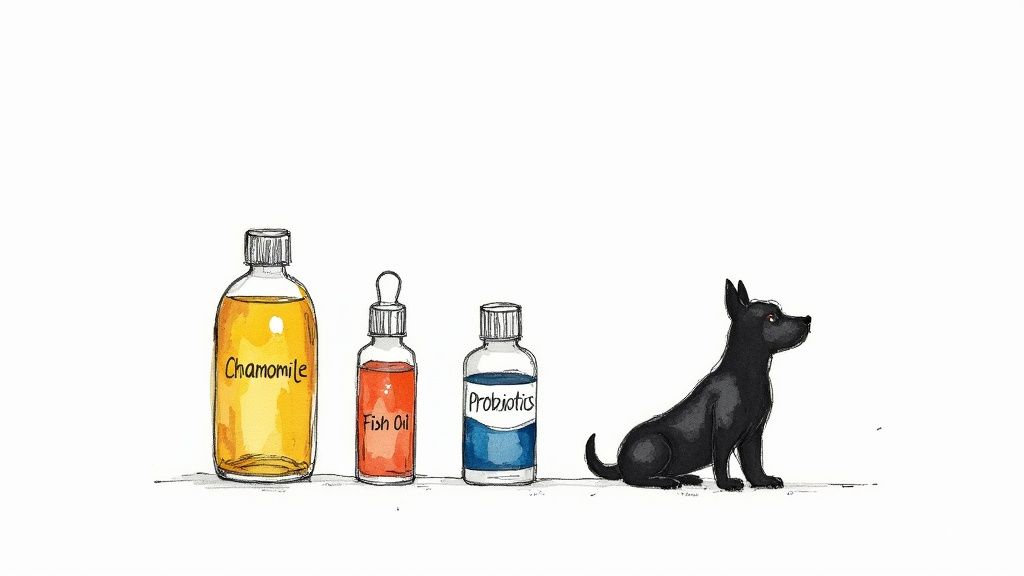When you're looking for a natural treatment for your dog's allergies, the goal is to get to the root of the problem. Instead of just masking the symptoms, we're aiming to support your dog’s body from the inside out. This means figuring out what's causing the reaction—whether it's something in the air, in their food bowl, or from a pesky flea—and then using a smart combination of diet changes, specific supplements, and soothing skin care to bring them relief.
It’s all about reducing that constant itching, calming inflammation, and getting your dog comfortable in their own skin again.
Decoding Your Dog's Itch: What Causes Allergies?
Before you can find the right solution, you have to truly understand the problem. Imagine your dog’s immune system is like an overzealous security guard. It's meant to protect them, but sometimes it mistakes completely harmless things—like pollen, dust mites, or a protein in their dinner—for a dangerous intruder.
This overreaction is what triggers the endless scratching, paw-licking, and general misery you're seeing. The first step to helping them is to become a "symptom detective." The clues your dog gives you are invaluable, helping you and your vet narrow down the possibilities and find a natural treatment for your dog's allergies that actually works.
The Three Main Allergy Culprits
Most allergic reactions in dogs can be sorted into one of three main buckets. Each has its own unique set of triggers and tell-tale signs, and knowing the difference is the key to managing them effectively.
- Environmental Allergies: This is the big one, affecting more dogs than any other type. The culprits are usually airborne substances like pollen, mould spores, and dust mites. The symptoms often have a seasonal pattern, flaring up in spring or autumn, and usually show up as intensely itchy skin, especially on the paws, face, and belly. If you've ever wondered why your dog is constantly licking his paw, environmental irritants are a very likely suspect.
- Food Allergies: A true food allergy is a specific immune response to a protein in your dog’s diet—chicken, beef, and dairy are common offenders. Unlike seasonal environmental allergies, the symptoms are year-round. Along with the classic itchy skin, you might also see digestive upset like diarrhoea or vomiting.
- Flea Allergies: Officially known as flea allergy dermatitis (FAD), this is an extreme allergic reaction to the saliva from just a single flea bite. It triggers severe, frantic itching and skin irritation, which is usually most intense around the base of the tail and down their back legs.
We're seeing a definite rise in canine allergies here in the UK, and with it, a growing number of pet owners are looking for natural alternatives to conventional medicines. Environmental triggers are a huge factor. Recent data shows that flea allergies affect around 1.8% of dogs, while environmental allergies impact a much larger 3.6%.
Common Dog Allergy Types and Their Telltale Signs
Feeling a bit lost trying to connect your dog's symptoms to a specific cause? This quick guide can help you pinpoint the most likely allergy type based on its common triggers and the signs you're seeing.
| Allergy Type | Common Triggers | Primary Symptoms |
|---|---|---|
| Environmental | Pollen, dust mites, mould spores, grass | Itchy paws, face, and belly; recurring ear infections; seasonal flare-ups. |
| Food | Common proteins (chicken, beef), dairy, wheat | Year-round itching; skin and ear issues; digestive upset (vomiting, diarrhoea). |
| Flea Allergy Dermatitis (FAD) | Saliva from flea bites | Intense itching, especially at the base of the tail; hair loss; scabs and hot spots. |
| Contact | Chemicals in shampoos, flea collars, certain fabrics | Red, irritated skin and rashes at the point of direct contact with the substance. |
By paying close attention to what symptoms appear and when they appear, you can start to piece together the puzzle and get a much clearer idea of what you're dealing with.

The data makes it pretty clear: environmental triggers are the number one cause of allergic reactions in our dogs, responsible for half of all cases. This insight is incredibly helpful because it gives us a starting point. When your dog starts showing signs of discomfort, investigating their environment is often the most logical first step.
Ultimately, pinpointing the specific cause is the single most important thing you can do on the path to finding lasting relief for your best friend.
Building a Strong Foundation With an Anti-Allergy Diet

When you're trying to get to the bottom of your dog's allergies, lasting relief often starts right in their food bowl. Nutrition is so much more than just fuel; it's your first and best line of defence. The right diet can help soothe an overactive immune system, dialling down the inflammation that leads to all that frustrating itching and discomfort.
Think of your dog’s diet as the foundation of a house. If that foundation is wobbly—built with ingredients that constantly trigger their immune system—their whole body will be on high alert. Creating a solid, anti-allergy diet is one of the most powerful natural steps you can take because it tackles the problem at its very source.
Identifying Food Triggers With an Elimination Diet
If you have a hunch that a food allergy is behind your dog's misery, a vet-guided elimination diet is the gold standard for figuring out the specific culprit. It's a bit like detective work, where you methodically isolate the ingredient causing all the trouble. The process involves temporarily feeding your dog a super-simple, pure diet using ingredients their body has never encountered before.
While it demands patience, the process itself is quite straightforward:
- Switch to a Novel Diet: With your vet's guidance, you’ll move your dog onto a food with a single novel protein (like venison or kangaroo) and a single carbohydrate (like sweet potato).
- Monitor for Improvement: You need to feed this stripped-back diet and absolutely nothing else for 8–12 weeks. That means no treats, no table scraps, and no flavoured supplements.
- Reintroduce Foods: If you see a clear improvement in symptoms, you can start reintroducing old food ingredients one by one, watching carefully to see if the allergic reaction returns.
This systematic approach really is the only reliable way to confirm a food allergy and pinpoint exactly what your dog needs to avoid.
Choosing the Right Anti-Allergy Food
Once you’ve identified a trigger—or even if you're just aiming to lower overall inflammation—switching to a specialised diet can make a huge difference. Limited-ingredient diets (LIDs) and those based on novel proteins are fantastic choices because they minimise exposure to common allergens.
By simplifying what goes into your dog's bowl, you reduce the chances of their immune system overreacting. The goal is to nourish their body without triggering the internal alarm bells that lead to itchy skin and digestive upset.
Many dog owners see significant relief just by moving away from common proteins like chicken and beef, which are in almost every commercial dog food. When you're looking for a new food, seek out diets that feature easily digestible, single-source proteins and are free from artificial additives and common grain fillers like wheat and corn.
The Gut-Immunity Connection
You might be surprised to learn that a huge portion of your dog’s immune system is located in their digestive tract. A healthy gut is absolutely central to a balanced immune response. When the gut is thriving with good bacteria, it creates a strong barrier that helps keep immune reactions in check.
Probiotics are these "good" bacteria, and they help reinforce this gut barrier, strengthening your dog's internal defences from the inside out. Adding a high-quality probiotic supplement to their routine can help calm inflammation and manage allergic responses more effectively in the long run. To get a better handle on this, you can learn more about how prebiotics and probiotics for dogs are fundamental to their overall well-being.
Targeted Relief with Natural Supplements

While a thoughtfully planned diet lays the groundwork, certain natural supplements can act like a special forces team, giving your dog's body the extra firepower it needs to beat back inflammation and soothe allergic reactions. Think of them as reinforcements, working from the inside out to calm that angry skin and turn down the volume on the constant itch.
This isn't just a niche idea anymore. The pet allergy treatment market in the UK shows a clear shift, with owners investing more in natural options alongside conventional drugs. A growing number of UK dog owners are exploring holistic avenues like herbs and diet changes, often driven by concerns over the side effects of long-term medication. You can see this trend reflected in this detailed pet allergy market report.
Omega-3 Fatty Acids: The Ultimate Skin Soother
If there's one superstar in the world of natural allergy relief for dogs, it's Omega-3 fatty acids. These essential fats, packed into fish oil, are renowned for their powerful anti-inflammatory properties. They get right to the heart of the problem, calming the immune response that leads to itchy, red skin.
On a deeper level, they help fortify the skin barrier itself, making it more resilient to environmental invaders like pollen and dust mites. A stronger, healthier barrier means less irritation and, as a bonus, a much glossier coat. When shopping, look for supplements made from cold-water fish like salmon, sardines, or anchovies, as they pack the most potent punch. You can learn more in our guide to the best dog skin supplements.
Quercetin: Nature's Antihistamine
What if you could find something in nature that helps stop an allergic reaction in its tracks? That's exactly what quercetin does. This plant-based compound is so effective it's often called "Nature's Benadryl."
Its magic lies in its ability to stabilise the mast cells in your dog's body. These are the cells that release a flood of histamine when they encounter an allergen, triggering the classic signs of itching, swelling, and redness. By keeping them calm, quercetin helps prevent the reaction from even starting. It's especially useful for dogs whose allergies flare up with the seasons.
Key Takeaway: Quercetin is more than just a symptom-soother. It works at the source to regulate the body's over-the-top response, making it a brilliant proactive tool for managing your dog's discomfort.
Probiotics: Fortifying The Gut-Immunity Connection
As we've already seen, a happy gut is the command centre for a balanced immune system. Good-quality canine probiotics introduce an army of beneficial bacteria into the digestive system. This strengthens the gut lining, creating a better barrier that stops allergens from "leaking" into the bloodstream where they can cause chaos.
A thriving gut microbiome essentially teaches the immune system to tell the difference between real threats and harmless things like pollen. This helps dial down its tendency to overreact. Because of this, probiotics are a cornerstone of any long-term strategy for managing allergies.
Here’s a quick look at how these three power players stack up:
| Supplement | Primary Action | Best For |
|---|---|---|
| Omega-3s | Reduces inflammation and strengthens the skin barrier. | General itchy skin, dry coat, environmental allergies. |
| Quercetin | Stabilises mast cells to block histamine release. | Seasonal environmental allergies (pollen, grass). |
| Probiotics | Balances gut bacteria to regulate the immune system. | Food sensitivities and long-term immune support. |
By using these supplements together, you can create a powerful, multi-layered defence, offering your dog natural and lasting relief from the misery of allergies.
Soothing Your Dog's Skin for Immediate Comfort
While you're working on building up your dog's internal defences with diet and supplements, their immediate comfort is paramount. A dog stuck in a cycle of non-stop itching needs fast, hands-on relief to calm their inflamed skin and finally break that awful scratch-damage-scratch pattern. This is where topical, natural treatments can be an absolute lifesaver.
Think of these strategies as the paramedics for your dog’s irritated skin. They deliver direct, targeted comfort right where it's needed, dialling down that intense urge to scratch and giving the skin a chance to start healing.
The Power of a Therapeutic Bath
A bath can be so much more than a way to get clean; it can be a genuinely therapeutic experience for an itchy dog. Using the right ingredients transforms a simple wash into a soothing session that calms irritation and brings almost instant relief. For centuries, oatmeal has been a go-to for its anti-inflammatory properties, which makes it a fantastic base for a gentle, allergy-friendly shampoo.
For the most effective therapeutic bath, follow these steps:
- Use Lukewarm Water: Hot water will only aggravate already sensitive skin, so keep the temperature comfortably lukewarm.
- Lather and Wait: Gently massage an oatmeal-based shampoo into your dog’s coat. The real trick here is to let it sit for a good 5-10 minutes before rinsing. This gives the active ingredients time to actually work their magic.
- Rinse Thoroughly: Make sure every last bit of shampoo is rinsed away. Any residue left behind can dry out the skin and cause more irritation.
- Pat, Don't Rub: Instead of vigorously rubbing your dog with a towel, gently pat them dry. This avoids friction that could make their sore skin even worse.
Applying Topical Sprays and Balms
For targeted relief between baths, especially on those angry red hotspots or particularly stubborn itchy patches, natural sprays and balms are invaluable. They allow you to deliver soothing ingredients directly to the trouble spots.
Look for products that feature gentle but effective botanicals. Aloe vera is brilliant for cooling and hydrating irritated skin, while calendula is well-known for its ability to reduce inflammation and promote healing. When you're buying a ready-made product, always scan the label to make sure it’s free from alcohol, artificial fragrances, and any harsh chemicals that could just make the problem worse.
You can easily whip up a simple and effective soothing spray at home. Just brew a strong cup of chamomile or green tea, let it cool completely, and pour it into a spray bottle. A light mist over your dog's irritated areas can work wonders, as both teas contain natural compounds that help calm inflammation and reduce that maddening itch.
By combining these immediate, hands-on strategies with the long-term internal support from the right diet and supplements, you create a truly comprehensive plan. This approach gives your dog the instant comfort they so desperately need while you get to work on resolving the root causes of their allergies for good.
Creating an Allergy-Friendly Home Environment

While sorting out your dog's diet and supplements tackles allergies from the inside, one of the most effective things you can do is control their immediate environment. It helps to think of your home as a bucket that’s constantly filling up with allergens like pollen, dust mites, and mould. When that bucket overflows, your dog’s immune system is tipped over the edge, and the frantic scratching begins.
Your job is to keep the level in that bucket as low as possible. By turning your home into a low-allergen sanctuary, you give their system a much-needed break from the constant barrage of triggers. This gives their body a chance to calm down, making everything else you're doing that much more effective.
A Room-by-Room Plan for Relief
You don’t need to completely gut your house to make it allergy-friendly. It’s all about building small, consistent habits that add up to make a huge difference. To get the most bang for your buck, focus your efforts on the areas where your dog spends most of their time, like the living room and wherever they sleep.
These simple, practical steps can seriously cut down on the allergens your dog is exposed to every single day:
- Rethink Your Cleaning Routine: Hoover carpets and soft furnishings at least twice a week, and make sure your vacuum has a HEPA (High-Efficiency Particulate Air) filter. A standard hoover just kicks dust back into the air, but a HEPA filter actually traps those microscopic irritants.
- Wash Bedding on a Hot Cycle: Your dog’s bed is a hotspot for dust mites. Make a point of washing their bedding, blankets, and any soft toys every week in water that’s at least 60°C. This is the temperature needed to properly kill off those pesky mites.
- Get an Air Purifier: Placing an air purifier (again, with a HEPA filter) in the room where your dog sleeps is a game-changer. It works away quietly, capturing airborne allergens like pollen and mould spores, ensuring the air they breathe all night is as clean as possible.
By actively managing your dog's environment, you're not just cleaning—you're performing a crucial part of their allergy management. Each speck of dust captured and pollen particle removed is one less thing their immune system has to fight against.
Managing Outdoor Allergens
Of course, the battle doesn’t stop at the front door. During high-pollen seasons, every walk can feel like navigating a minefield of allergens. Irritants cling to your dog's coat and paws, just waiting to be tracked all through your carefully cleaned home. This is where a simple post-walk ritual becomes absolutely essential.
With approximately 27% of UK adults now owning a dog, the nation's canine population has shot past 10 million. This boom in pet ownership, along with environmental factors tied to modern living, means more dogs than ever are struggling with allergies. You can read more about the rise of dog allergies in the UK on yorktest.com.
A quick wipe-down can be the difference between a calm evening and a major flare-up. Keep a damp cloth or some pet-friendly wipes by the door and get into the habit of cleaning your dog’s paws, belly, and face after every single trip outside. It’s a five-minute job, but it’s honestly one of the most powerful ways to stop pollen in its tracks and a vital part of any natural allergy treatment plan.
Got Questions About Natural Allergy Care for Your Dog?
When you start looking into natural ways to help your dog with their allergies, it's completely normal for a lot of questions to pop up. You're trying to do the best for your furry friend, and that means making choices that are not just effective, but safe. Let's tackle some of the most common queries I hear from dog owners, so you can feel confident in your plan.
Getting a handle on timelines, safety, and knowing when to call the vet is the foundation of any good treatment strategy. We'll clear up the confusion and get you on the right path to helping your dog feel much, much better.
How Long Until I See a Difference with Natural Treatments?
This is a big one, and the answer is all about patience and consistency. Natural approaches aren't like a quick-fix pill that just masks the symptoms. Instead, they work with your dog's body, helping it to heal and find its balance again. It’s a gentler, more gradual process, but the results are often more lasting.
If you're making dietary changes, like trying an elimination diet, you need to stick with it for a solid 8 to 12 weeks to know if it's truly working. For supplements like Omega-3s, you're looking at about 4 to 8 weeks before you'll likely notice real improvements in their skin and coat. While topical sprays and balms can offer some instant relief, think of them as supportive care—the real, long-term change comes from working on the inside.
Can I Just Give My Dog a Human Antihistamine?
Please, don't ever give your dog any human medication without your vet telling you to, and that absolutely includes antihistamines. The dose that's right for a human can be completely wrong, even dangerous, for a dog. Plus, many over-the-counter remedies contain other ingredients, like decongestants, which are highly toxic to dogs.
While a vet might, in very specific cases, recommend a certain type and dose, trying to guess yourself is a recipe for disaster. It's far safer to stick to dog-specific natural options like quercetin or to focus on getting their diet right. This way, you're managing their allergies without risking accidental harm.
Your vet is your most important partner in your dog's health. Their expertise is what ensures any plan, natural or conventional, is perfectly suited to your dog's specific needs, size, and health history.
When Is It Time to Call the Vet?
Before you start any new treatment, you really should see your vet for a proper diagnosis. That relentless itching could be allergies, but it could also be something else entirely, like mites, fleas, or a bacterial infection. Getting the diagnosis right from the start is absolutely crucial.
Make an appointment straight away if you see any of these red flags:
- Signs of an infection: This could be a nasty smell from the skin, any pus, or a lot of crusty scabs.
- Self-inflicted wounds: If your dog is scratching or licking so much that they're creating raw sores or hotspots.
- Other worrying symptoms: If the skin problems are happening alongside things like low energy, a change in appetite, or an upset tummy.
Your vet can help you build a safe and effective plan to tackle your dog’s allergies, making sure you’re treating the real problem without overlooking something more serious.
At Tipaw, we're all about supporting your dog’s health from the inside out with top-quality, vet-approved supplements. Our natural chews are made to help with common problems like allergies and itching, giving your best friend the targeted support they need. You can check out our trusted solutions at https://www.store-tipaw.com.





